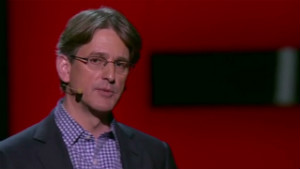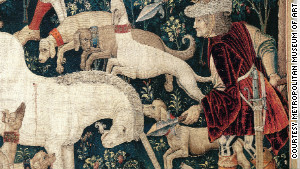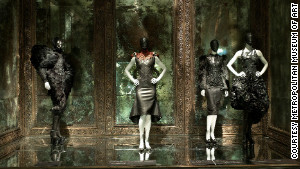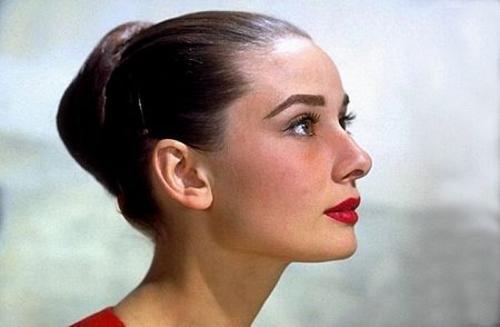Wednesday, October 31, 2012
Thursday, October 25, 2012
Sunday, October 21, 2012
Provenance, forensic analysis in the HUGE money world of Art
Lawsuits Claim Knoedler Made Huge Profits on Fakes
By PATRICIA COHEN
Published: October 21, 2012
For more than a dozen years the Upper East Side gallery Knoedler & Company
was “substantially dependent” on profits it made from selling a
mysterious collection of artwork that is at the center of a federal
forgery investigation, former clients of this former gallery have
charged in court papers.
Tina Fineberg for The New York Times
The former Knoedler Gallery in its town house, at 19 East 70th Street.
The analysis is based on financial records turned over as part of a
lawsuit against the gallery filed by Domenico and Eleanore De Sole, who
in 2004 paid $8.3 million for a painting attributed to Mark Rothko that
they now say is a worthless fake.
The Rothko is one of approximately 40 works that Knoedler, which closed last year, obtained from Glafira Rosales,
a little-known dealer whose collection of works attributed to Modernist
masters has no documented provenance and is the subject of an F.B.I.
investigation.
Between 1996 and 2008, the suit asserts, Knoedler earned approximately
$60 million from works that Ms. Rosales provided on consignment or sold
outright to the gallery and cleared $40 million in profits. In one year,
2002, for example, the complaint says the gallery’s entire profit —
$5.6 million — was derived from the sale of Ms. Rosales’s works.
“Knoedler’s viability as a business was substantially — and, in some
years, almost entirely — dependent on sales from the Rosales
Collection,” the De Soles claimed last month in an amended version of
the suit they filed this year.
While the forgery allegations are well known and have been the subject
of three federal lawsuits against Knoedler, the recent filings expand
the known number of Rosales artworks that were handled by the gallery,
which was in business for 165 years, and assert that they played a
pivotal role in the gallery’s success. After the F.B.I. issued subpoenas
to the gallery in the fall of 2009, Michael Hammer, Knoedler’s owner,
halted the sale of any Rosales works. Knoedler ended up losing money
that year and in 2010, the court papers say.
Lawyers for the gallery and its former president Ann Freedman declined
to discuss the accuracy of the De Soles’ financial analyses. But they
suggested the level of profits is irrelevant if the artworks sold were
the authentic and valuable works of acknowledged masters; the gallery
and Ms. Freedman still insist on their authenticity.
“Labeling a work a forgery is an extreme step,” Luke Nikas, one of Ms.
Freedman’s lawyers, said in an interview, “especially when substantial
evidence of authenticity exists. Plaintiffs’ irresponsible lawsuits
caused the very harm they complain of.”
Ms. Rosales’s lawyer has said that his client never knowingly defrauded anyone.
The size of the profits is significant, the De Soles contend, because
they say the gallery should have realized that someone cannot buy
undiscovered masterpieces for the prices Knoedler paid Ms. Rosales. For
example, Knoedler paid her $950,000 in 2003 for the untitled Rothko that
it sold the following year to the De Soles for a 773 percent markup.
John D. Howard, another former Knoedler customer who is suing, paid $3.5
million for a work said to be by Willem de Kooning (plus a $500,000
commission to an intermediary dealer), a 366 percent markup over the
$750,000 that Knoedler had paid to Ms. Rosales just two days earlier. In
his complaint Mr. Howard’s lawyer, John Cahill, described the $750,000
as “a price so low it virtually announced its dubious nature.”
(A third suit, over the authenticity of a $17 million painting
attributed to Jackson Pollock, was settled this month in a confidential
agreement.)
Of course buying cheap and selling high is every seller’s goal. And Ms.
Freedman, few would dispute, is a good saleswoman. But several art
dealers described the markups as unusual. Speaking generally Michael
Findlay, a director of Acquavella Galleries in New York, said a price
way below market should be a “red flag.”
“Why is it so cheap?” he said. “That’s a smell test.”
One reason for the low prices, though, is the lack of paperwork
attesting to provenance. Ms. Freedman’s lawyers said that the payments
to Ms. Rosales reflected the enormous risk Knoedler undertook as well as
the substantial costs of researching, conserving and evaluating the
newly uncovered art. That research confirmed the authenticity of the
works, and thus their value, the lawyers said.
Ms. Rosales has said the bulk of the newly discovered masterworks came
from an old family friend, an anonymous collector whom she has
steadfastly refused to name. Files at Knoedler about him were labeled
“Secret Santa.”
Ms. Rosales said the collector had inherited the works — about two dozen
major pieces by artists like Franz Kline, Robert Motherwell, Pollock
and de Kooning — from his father, a European émigré with homes in
Switzerland and Mexico.
But the lawsuits state that over the years Ms. Rosales altered her
account in several ways. For example, after saying the art was acquired
in the 1950s with the help of Alfonso Ossorio, a painter and a friend of
Pollock’s, she later identified a different middleman when an
independent art panel called Mr. Ossorio’s involvement “inconceivable,”
the papers report.
According to Ms. Freedman’s lawyers Ms. Rosales at one point told Ms.
Freedman to stop pressing for more information about the unnamed
collector, saying, “Don’t kill the goose that’s laying the golden egg.”
At the moment 14 works Ms. Rosales brought to market — 9 of which were
handled by Knoedler — have been judged as fake by authenticating bodies.
A company called Orion Analytical
also conducted forensic tests on at least five Rosales paintings and
reported that materials on the canvasses were not available or were
inconsistent with the dates on the works.
To counter the charges Ms. Freedman’s and Knoedler’s lawyers have
collected affidavits from two experts who vouch for the authenticity of
the art along with other evidence. For example, to rebut the idea that
paint found on the Rosales Pollock work was not available in Pollock’s
day, the lawyers cite a 1980 interview that Lee Krasner, Pollock’s
widow, gave The Partisan Review in which she said that Pollock “at one
point got DuPont to make up very special paints for him, and special
thinners.”
Charles D. Schmerler, Knoedler’s lawyer, dismissed Orion’s conclusions:
“Certain individuals appear to be creating a cottage industry out of
attacking these paintings. There are no accepted scientific methods or
standardized guidelines in this area.”
And as Ms. Freedman herself said in a recent e-mail, “These paintings
were exhibited in museums around the world and heralded as masterworks.”
Art Dealer Admits to Role in Fraud
By WILLIAM K. RASHBAUM and PATRICIA COHEN
Published: September 16, 2013
The Long Island dealer at the center of an $80 million art forgery
scheme that duped dozens of experts and buyers pleaded guilty on Monday
to charges of wire fraud, money laundering and tax evasion.
John Marshall Mantel for The New York Times
Glafira Rosales, center, outside United States District Court in Manhattan on Monday.
The dealer, Glafira Rosales, is the only person who has been indicted in
connection with the fraud, which passed off fake paintings as the work
of Modernist masters. But she is cooperating with federal prosecutors,
who have said that they expect further arrests.
What has particularly fascinated the art world is that the scores of
paintings and drawings successfully presented as newly discovered works
by some of the 20th century’s greatest artists were actually produced by
a single man: an immigrant from China who painted out of his home and
garage in Woodhaven, Queens.
Ms. Rosales, wearing a charcoal pinstripe jacket and speaking in a
halting, barely audible voice, acknowledged to Judge Katherine P. Failla
in United States District Court in Manhattan that she had promoted
paintings as the work of Mark Rothko, Jackson Pollock and Robert
Motherwell that “were, in fact, fakes created by an individual in
Queens.”
Investigators have said that 40 of the counterfeits were sold through
Knoedler & Company, a venerable Upper East Side gallery that
abruptly closed in November 2011 after being in business for more than
165 years. At least 23 other fakes were sold through a second Manhattan
dealer, Julian Weissman. Ms. Rosales earned $33.2 million, while the
galleries received more than $47 million in total, according to a statement issued by the Manhattan United States attorney, Preet Bharara.
Knoedler; Ann Freedman, its former president; and Mr. Weissman are being
sued in civil court by various clients who bought art provided by Ms.
Rosales; they have all said that they were convinced that the works were
genuine, though they have acknowledged that Ms. Rosales did not provide
them with documentation to establish the art’s provenance.
In court, Ms. Rosales, who had been arrested in May, dabbed at her eyes
with a tissue after she detailed her role in the fraud and listened to
the judge explain that she could owe up to $81 million in restitution
and have to forfeit her home in Sands Point, N.Y.; her art collection;
and her bank accounts. She also faces a maximum sentence of 99 years in
prison, although her recommended sentence under federal sentencing
guidelines is likely to be far less.
Ms. Rosales’s co-conspirators are not named in the indictment. But
people familiar with the case have identified the painter as Pei-Shen
Qian, 73, a Chinese immigrant who came to the United States in 1981 and
attended classes at the Art Students League in New York. He was
discovered in the 1980s by Ms. Rosales’s partner and former boyfriend,
who was named in the government’s papers only as co-conspirator “CC-1,”
but is identified in other court documents as Jose Carlos Bergantiños
Diaz.
Both men were involved in marking the counterfeits with false
signatures, according to the statement issued by Mr. Bharara’s office.
The prosecutors said CC-1 had treated the works to give them “the false
patina of age.”
Mr. Qian was paid as little as a few thousand dollars for each work.
Beginning in 1994, Ms. Rosales wove a story about these
never-before-seen works, telling Knoedler and Mr. Weissman that the
owner had inherited the works from his father and insisted on remaining
anonymous.
Mr. Bergantiños Diaz and Mr. Qian are believed to be out of the country.
Most of the profits garnered by Ms. Rosales through the sale of the
fakes were funneled through a bank account in Spain controlled by Mr.
Bergantiños Diaz’s brother, according to court papers.
Ms. Freedman’s lawyer, Nicholas A. Gravante Jr., said, “I have been
assured in the strongest terms that nobody is contemplating filing any
criminal charges against Ann Freedman.”
Friday, October 12, 2012
Class 2012-2013!!! Met TRIP IS ON!
 |
| Trip to Metropolitan Museum is on for Friday, November 2nd--We're all booked up! |

What we see when we see art
By Thomas P. Cambell, Special to CNN
updated 11:13 AM EDT, Sun October 21, 2012

Great art -- see it for yourself
STORY HIGHLIGHTS
- Thomas Campbell: I learned from art teacher who shunned jargon, academic classification
- He says he was inspired to view art as a window into understanding how people live
- Key questions are how art was made and why it was made, he says
- Campbell: Museums should be places where people meet with art across time, space
Editor's note: Thomas P. Campbell is director and CEO of the Metropolitan Museum of Art.
He spoke at the TED 2012 conference in March. TED is a nonprofit
organization dedicated to "ideas worth spreading," which it makes
available through talks posted on its website.
(CNN) -- When I was considering a career in the art
world, I took a course in London with a teacher who changed my
perspective on art.
He drank too much, smoked
too much, and swore too much — which didn't make it easy to be his
student — but what I learned from him helped guide my curatorial career
and remains a touchstone for me as director of the Metropolitan Museum
of Art.
This teacher was always
suspicious of formal art history training, as he felt that it filled his
students with jargon and compelled them to merely classify things.
 Director of the Met on curating museum
Director of the Met on curating museum
His goal was to
demonstrate how to really see a work of art, reminding us that all art
was once contemporary and encouraging us to ask basic questions: What is
it? How was it made? Why was it made?
I would later apply these
questions to the field of tapestries, a neglected area of art history
despite the central role these objects played in the past as a potent
form of propaganda.
I came to the Met as a
curator in 1995 and set out to organize a groundbreaking show about
Renaissance tapestry. I designed my 2002 exhibition to be an experience,
a spectacle of wall-high images saturating the galleries with lavish
court scenes, hunters crashing through thick woods in pursuit of their
prey, and violent battles depicted in a medium that was the IMAX of its
time. The success of the show was gratifying; I had exposed the public
to something they had never before considered.
Become a fan of CNNOpinion
Stay up to date on the latest opinion, analysis and conversations through social media. Join us at Facebook/CNNOpinion and follow us @CNNOpinion on Twitter. We welcome your ideas and comments.
As the director of the
Met, I still believe passionately in that carefully curated experience.
We live in a world of ubiquitous information and just-add-water
expertise, but there is nothing that compares to the presentation of
works of art in a narrative that is both informed by scholarship and
captivating to the public.

"The Unicorn Defends Itself," a tapestry dating from 1495-1505 in the collection of the Metropolitan Museum of Art.
Indeed, my job now is
the same as my early teacher: to encourage our visitors to really see
the art in the Met's galleries, whether it's a Samurai sword or the
fashion of Alexander McQueen.
Our 2011 Alexander
McQueen exhibition is actually an excellent example. Instead of an
extensive shop-window display, it was an immersive journey into the mind
of a man who was not just a clothing designer, but a storyteller,
filmmaker and conceptual artist.

A display from the exhibition "Alexander McQueen: Savage Beauty," The Metropolitan Museum of Art, 2011.
The research and vision
of Met curator Andrew Bolton brought that complexity forward and made
the exhibition exceptionally moving for our visitors, many of whom
waited over five hours to see it.
Individual objects in
the Met's collection can have the same power as these major exhibitions.
The Met was established in 1870 not as a museum of American art, but as
an encyclopedic museum, and it now includes works of art from every
corner of the globe.
Today, the prescience of
that founding mandate is felt more than ever as 24-hour news coverage
has us digesting the world at an ever-quickening pace. The works of art
in the Met's galleries allow people to slow down that cycle, tap into a
broader historical context and better understand the cultures at the
center of current events. Think of Libya, Syria and Egypt.

The 2000-year-old Temple of Dendur is displayed in the Sackler Wing of the Metropolitan Museum of Art, New York.
Daily, our visitors confront objects like the Temple of Dendur
from c.15 BC, an ancient Egyptian structure built by the Roman Emperor
Augustus, who, as ruler of Egypt, had himself depicted as a pharaoh
(politicians still use regional traditions, though now that means eating
cheese steaks).
To see this structure —
its actual stones carved by hand and surviving two millennia — now
sitting alongside traffic passing through Central Park speaks powerfully
about the passage of time and the longevity of human civilization.
If visitors look
closely, they can see 18th-century graffiti left by European travelers
who over 200 years ago considered this object with the same awe.
Suddenly, our moment in history seems tiny.
Certainly our galleries for Islamic art
also make this point. Opened 10 years after 9/11, almost to the day,
and tracing the development of Islamic cultures over 14 centuries and
across a vast geographic expanse, these galleries have received more
than 800,000 visitors since they opened a year ago, a resounding
endorsement of both the power of actual objects in a virtual world and
the public interest in a culture that had little resonance for many
Americans before the 2001 tragedy.
In the end, I want the
Met to be a place where people meet not only with friends or on a date,
but with works of art across time and space.
But let's face it, museums can be intimidating, and spending time being intimidated is exhausting.
Museums can also be
boring if you feel like this old stuff has nothing to do with you. My
job is to relax our visitors so they can sense a connection, get
excited, explore, try the unknown and follow their curiosity. That means
ditching the jargon, but not the scholarship, and getting to the real
work of inspiring the public to look around and find themselves.
The opinions expressed in this commentary are solely those of Thomas P. Campbell.
Subscribe to:
Posts (Atom)





